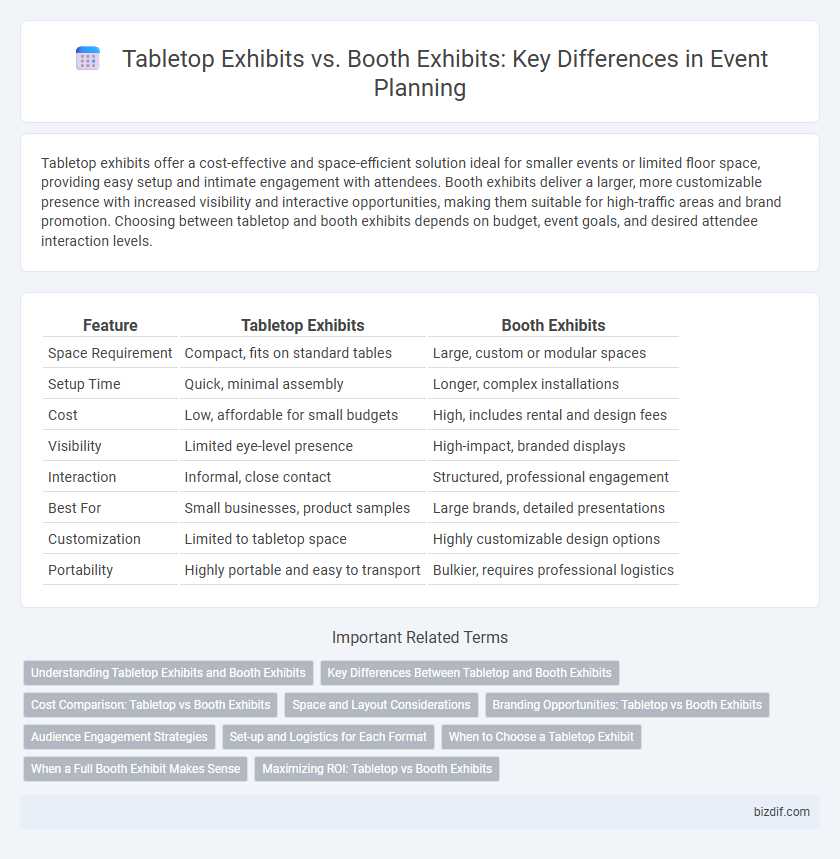Tabletop exhibits offer a cost-effective and space-efficient solution ideal for smaller events or limited floor space, providing easy setup and intimate engagement with attendees. Booth exhibits deliver a larger, more customizable presence with increased visibility and interactive opportunities, making them suitable for high-traffic areas and brand promotion. Choosing between tabletop and booth exhibits depends on budget, event goals, and desired attendee interaction levels.
Table of Comparison
| Feature | Tabletop Exhibits | Booth Exhibits |
|---|---|---|
| Space Requirement | Compact, fits on standard tables | Large, custom or modular spaces |
| Setup Time | Quick, minimal assembly | Longer, complex installations |
| Cost | Low, affordable for small budgets | High, includes rental and design fees |
| Visibility | Limited eye-level presence | High-impact, branded displays |
| Interaction | Informal, close contact | Structured, professional engagement |
| Best For | Small businesses, product samples | Large brands, detailed presentations |
| Customization | Limited to tabletop space | Highly customizable design options |
| Portability | Highly portable and easy to transport | Bulkier, requires professional logistics |
Understanding Tabletop Exhibits and Booth Exhibits
Tabletop exhibits typically consist of a small display set up on a standard table, ideal for intimate, face-to-face interactions and limited product showcases at trade shows or conferences. Booth exhibits offer larger, more customizable spaces with backdrops, signage, and multimedia elements, designed to attract higher foot traffic and create immersive brand experiences. Understanding the differences helps event planners select the appropriate exhibit type based on budget, space availability, and engagement goals.
Key Differences Between Tabletop and Booth Exhibits
Tabletop exhibits are compact displays set on tables, ideal for small spaces and low-budget events, focusing on direct interaction and easy setup. Booth exhibits involve larger, self-contained structures with walls and overhead graphics, designed to create immersive brand experiences and accommodate more complex presentations. Key differences include space requirements, customization options, and overall visibility, with booths offering greater impact and table tops providing convenience and cost-efficiency.
Cost Comparison: Tabletop vs Booth Exhibits
Tabletop exhibits generally cost significantly less than booth exhibits due to their smaller size and reduced space rental fees, making them ideal for companies with limited budgets. Booth exhibits require higher expenditures not only for larger floor space but also for elaborate setups, including custom branding, lighting, and technology integration. For businesses prioritizing cost-efficiency, tabletop exhibits offer a streamlined presence with lower overall investment, whereas booth exhibits provide greater visibility at a premium price point.
Space and Layout Considerations
Tabletop exhibits typically require less space, making them ideal for smaller venues or events with limited floor area, whereas booth exhibits demand more extensive space to accommodate walls, signage, and interactive elements. The layout for tabletop exhibits centers around a compact, often single-surface display that maximizes visibility within a confined footprint, while booth exhibits involve a larger, multi-dimensional setup designed to engage visitors from multiple angles. Effective planning must consider attendee flow and sightlines to optimize each exhibit type's spatial advantages and ensure maximum engagement.
Branding Opportunities: Tabletop vs Booth Exhibits
Tabletop exhibits offer compact branding opportunities ideal for intimate networking environments, maximizing logo visibility and promotional material placement within a smaller footprint. Booth exhibits provide expansive space for immersive branding, incorporating large-scale graphics, multimedia displays, and interactive elements to attract and engage larger audiences. Selecting between tabletop and booth exhibits depends on the event scale and the desired impact of your brand presence.
Audience Engagement Strategies
Tabletop exhibits foster intimate audience engagement through close interactions and personalized demonstrations, making them ideal for smaller spaces and focused conversations. Booth exhibits, with their larger footprint and multimedia capabilities, attract wider attention and facilitate dynamic visual storytelling to engage diverse crowds. Employing interactive elements like touchscreens or live presentations enhances participant involvement in both setups, driving deeper connections and memorable experiences.
Set-up and Logistics for Each Format
Tabletop exhibits require minimal setup and are ideal for small spaces, often involving just a table and display materials, making logistics simpler and faster. Booth exhibits demand more extensive setup with modular structures, lighting, and sometimes electrical installations, which increases the complexity of transportation and setup time. Effective logistics management for booth exhibits includes planning for larger freight handling, advanced scheduling, and precise spatial organization within the event venue.
When to Choose a Tabletop Exhibit
Tabletop exhibits are ideal for small-scale events or tight spaces where a full booth footprint is impractical, providing a cost-effective solution for engaging attendees. They work best at trade shows or conferences with limited exhibitor floor space and when the goal is to facilitate one-on-one interactions through concise, impactful displays. Companies aiming for streamlined setups and maximum mobility should prioritize tabletop exhibits over larger booth exhibits to optimize visibility and engagement.
When a Full Booth Exhibit Makes Sense
A full booth exhibit makes sense when brands seek maximum visibility, ample space for interactive displays, and opportunities for private meetings during an event. These exhibits often include walls, storage, and multimedia setups, enhancing engagement and professional presentation, especially at large trade shows or industry conferences. Opting for a full booth boosts brand impact and allows exhibitors to showcase products or services comprehensively.
Maximizing ROI: Tabletop vs Booth Exhibits
Maximizing ROI in event planning hinges on selecting between tabletop and booth exhibits based on budget, space, and engagement goals. Tabletop exhibits offer cost-effective exposure and ease of setup, ideal for small budgets and single-person teams, while booth exhibits provide larger spaces for immersive branding, interactive displays, and attracting higher foot traffic. Analyzing event demographics and lead generation potential helps determine whether a compact tabletop or expansive booth exhibit yields the best return on investment.
Tabletop exhibits vs Booth exhibits Infographic

 bizdif.com
bizdif.com